Upper Swabia
This article needs additional citations for verification. (November 2009) |

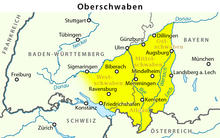







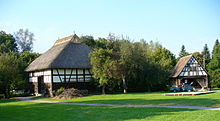
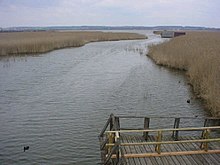

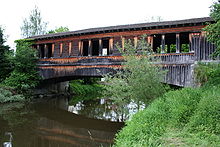

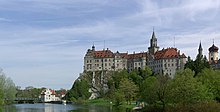





Upper Swabia (German: Oberschwaben or Schwäbisches Oberland) is a region in Germany in the federal states of Baden-Württemberg and Bavaria.[1] The name refers to the area between the Swabian Jura, Lake Constance and the Lech. Its counterpart is Lower Swabia (Niederschwaben), the region around Heilbronn.
Geography
The region of Upper Swabia is situated in the central south of Germany consisting of the south-east of Baden-Württemberg and the south-west bavarian
Due to Upper Swabia's altitude and hilly terrain, agriculture consists mainly of dairy farming, the exception being the basin of the river Schussen, where the predominant produce is hops and fruits.
Upper Swabia is still a very rural area dominated by villages. The urban population is concentrated in the cities of Augsburg, Friedrichshafen, Ravensburg & Weingarten and Biberach an der Riß as well as Memmingen and Günzburg.
The eastern border of Upper Swabia has been disputed for some time. Historically, the river
The inhabitants of the former
Administration
Upper Swabia is part of the Regierungsbezirk Tübingen, a Regierungsbezirk being a sub-division of a federal state.
The following districts are wholly or partially part of Upper Swabia:
- Alb-Donau
- Biberach
- Bodenseekreis (Lake Constance)
- Ravensburg
- Reutlingen
- Sigmaringen
- Ulm
History
Upper Swabia has been populated at least since the Neolithic age. Archaeological evidence confirming this was discovered around the Federsee, a lake near Bad Buchau. Until around the year 260 CE, the region that was to become Upper Swabia, was part of the
During the
During the
From the
During the
During the revolt, numerous castles and monasteries in Upper Swabia were destroyed by the peasants. By July 1525, however, the rising had been utterly suppressed in Upper Swabia, with countless peasants losing their lives either due to battles or due to punitive measures inflicted upon them afterwards by their lords. Economically and socially, the consequences were dramatic: whole communities were bankrupt and unable to pay proper taxes for a long time, the legal position of peasants was not to be altered for another 300 years, and due to the large number of outlawed peasants trying to survive by illegal means, such as robbery, commerce was severely hindered.
This instability was one of the factors that lead to Upper Swabia's becoming a plaything of marauding armies during the
After the end of the war,
During the
The aristocratic dynasties that ruled Upper Swabia for centuries still have considerable political and economic influence and power. After
After
Tourism
Theme routes
- The Upper Swabian Baroque Route has several branches, leading from Ulm to Lake Constance and back again. During the age of Counter-Reformation in the 17th and 18th century, a large number of churches, abbeys and secular buildings were built inBaroque-style.
- The spa towns, recognizable by the designation Bad.
- The eastern leg of the German Half-Timbered Buildings Route leads from Bad Urach to Lake Constance, passing through Biberach an der Riß, Riedlingen, Pfullendorf and Meersburg.
- The Upper Swabian Mill Route was established in 2005 and passes along more than 100 grinding mills in the region.
Vantage points
| Name | Elevation | Description |
|---|---|---|
| Höchsten | 833 m (2733 ft) | The highest mountain in Upper Swabia is a popular vantage point; situated approximately 17 km north of Lake Constance in western Upper Swabia. |
| Waldburg Castle | 772 m (2533 ft) | Situated on top of a cone-shaped mountain to the east of Ravensburg. |
| Bussen | 767 m (2516 ft) | The "Holy Mountain of Upper Swabia", also a place of pilgrimage. |
| Gehrenberg | 754 m (2474 ft) | Mountain in the vicinity of Markdorf. On top of the mountain, there is an observation tower with views of Lake Constance and the Alps (weather permitting). |
| Grabener Höhe | 754 m (2474 ft) | Located between Bad Waldsee and Bad Wurzach, it offers views on the Alps and the Wurzacher Ried, one of the largest bog areas in Central Europe. |
In spite of this, the touristic development of Upper Swabia has been rather slow during the last decennia.[
Regional media
Print media
- Schwäbische Zeitung (Swabian Newspaper), based in Leutkirch im Allgäu; most read daily .
- Südwest-Presse (South-Western Press)), based in Ulm, mostly read in northern Upper Swabia, and its counterpart for the region around Lake Constance the Südkurier ('Southern Courier') based in Konstanz.
- Wochenblatt (Weekly Paper), free weekly newspaper, based in Biberach an der Riß.
- Memminger Kurier (Weekly Paper), free weekly newspaper, based in Memmingen
Radio and television
- Südwestrundfunk ('Southwest Broadcasting') have local and regional studios for radio and television broadcasts in Ulm and Friedrichshafen.
- REGIO TV Euro 3, regional television channel for southern Upper Swabia.
- Radio 7, commercial radio station, based in Ulm with several local studios throughout the region.
- Donau 3 FM, local commercial radio station, based in Ulm, for the surrounding region.
- RT1-Südschwaben, local commercial radio station, based in Memmingen, for the surrounding region between Memmingen, Mindelheim and Illertissen
Infrastructure
Railways
Upper Swabia is criss-crossed by several railway lines:
- Württembergische Südbahn (Wurttembergian Southern Railway), the most important railway line, linking Ulm with Friedrichshafen on Lake Constance. At Laupheim-West station a railway line branches off, connecting the city of Laupheim with the main artery of the Wurttembergian Southern Railway. Originally this railway line extended as far as the municipality of Schwendi. In Warthausen, the so-called Öchsle, a narrow-gauge railway line to Ochsenhausen, branches off. These days, the Öchsle is only used as a museum railway line. From May to October, it runs every weekend and on public holidays too, from July until September also on Thursdays. Additionally, there are extra tours during the winter months.
- Württembergische Allgäubahn (Wurttembergian Allgäu Railway), connecting Aulendorf with Memmingen
- Donautalbahn (Danube Valley Railway), leading from Ulm via Sigmaringen to Donaueschingen in Baden. Finally
- Zollernalbbahn (Zollern Alb Railway), which on its stretch from Aulendorf to Sigmaringen passes through Upper Swabia, before leading on to Tübingen across the Swabian Alb mountain range, passing the ancestral home of the dynasty of the Hohenzollern, hence the name of the railway line.
Roads
There are no
- Bundesstraße 31, along the northern shore of Lake Constance.
- Bundesstraße 311, from Ulm to Sigmaringen.
- Bundesstraße 30, from Ulm to Friedrichshafen.
- Bundesstraße 32, from Sigmaringen to Wangen.
- Bundesstraße 33, from Ravensburg to Meersburg.
- Bundesstraße 312, from Riedlingen to Memmingen.
- Bundesstraße 465, from Ehingen to Leutkirch im Allgäu.
- Kressbronn.
- Bundesautobahn 7
- Bundesautobahn 96
Airports
- charter flightsto popular holiday destinations.
- charter flightsto popular holiday destinations.
See also
- Baden-Württemberg
- Swabia region
- Upper Swabian Baroque Route
References
- ^ Brockhaus Enzyklopädie. 19. Auflage. Band 16, 1991, p. 72.
Further reading
- Blickle, Peter (1996), Oberschwaben. Politik als Kultur einer deutschen Geschichtslandschaft, Tübingen: Bibliotheca-Academica-Verlag, ISBN 3-928471-14-7
- Blickle, Peter; Schmauder, Andreas (2003), Die Mediatisierung der oberschwäbischen Reichsstädte im europäischen Kontext, Epfendorf: Bibliotheca-Academica-Verlag, ISBN 3-928471-38-4
- Brachat-Schwarz, Werner (1996), Die Region Bodensee-Oberschwaben und ihre Landkreise: Landkreise Bodenseekreis, Ravensburg, Sigmaringen, Stuttgart: Metzler-Poeschel, ISBN 3-923292-57-0
- Brachat-Schwarz, Werner (1999), Die Region Donau-Iller mit Stadtkreis und Landkreisen, Stuttgart: Statistisches Landesamt, ISBN 3-923292-82-1
- Hahn, Joachim (1991), Urgeschichte in Oberschwaben und der mittleren Schwäbischen Alb. Zum Stand neuerer Untersuchungen der Steinzeit-Archäologie, Stuttgart: Gesellschaft für Vor- und Frühgeschichte in Württemberg und Hohenzollern, ISBN 3-927714-09-7
- Huber, Eduard J. (2002), Mein Ried. Erinnerungen an eine Landschaft: Das Wurzacher Ried, Bad Wurzach: Bund für Naturschutz in Oberschwaben e.V.
- Köhler, Stefan; Hammer, Marcus (2000), Pendlerverkehr in der Region Bodensee-Oberschwaben, Ravensburg: Regionalverband Bodensee-Oberschwaben
- Michael, Kösel (1996). "Der Einfluss von Relief und periglazialen Deckschichten auf die Bodenausbildung im mittleren Rheingletschergebiet von Oberschwaben". Diss. Geographisches Institut der Universität Tübingen.
{{cite journal}}: Cite journal requires|journal=(help) - Kolb, Raimund; Brüning, Rolf; Günzl, Bernhard (2005), Bähnle, Öchsle, Hopfenexpress. Eisenbahn-Romantik in Oberschwaben, Hövelhof: DGED Medien, ISBN 3-937189-12-2
- Kramer, Ferdinand (2005), Der Bussen, heiliger Berg Oberschwabens, mit seiner Kirche und Geschichte, Bad Buchau: Federsee-Verlag, ISBN 3-925171-60-6
- Kuhn, Elmar L. (2000), Der Bauernkrieg in Oberschwaben, Tübingen: Bibliotheca-Academica-Verlag, ISBN 3-928471-28-7
- Kuhn, Elmar L. (2006), Oberschwaben - politische Landschaft, Bewußtseinslandschaft, Geschichtslandschaft, Eggingen: Edition Isele
- Liesch, Franz (2004), Baltringer Haufen. Bauernkrieg in Oberschwaben (2nd ed.), Baltringen: Verein Baltringer Haufen
- Marmann, Bettina (1997), Innenstadt und Verkehr in der Region Bodensee-Oberschwaben (2nd ed.), Weingarten: IHK Bodensee-Oberschwaben
- Morsbach, Peter (1999), Oberschwaben und Schwäbische Alb. Kunst, Kultur und Landschaft zwischen mittlerem Neckar und Iller, Köln: DuMont, ISBN 3-7701-4701-4
- Petz, Wolfgang (1989), Reichsstädte zur Blütezeit 1350 bis 1550. Alltag und Kultur im Allgäu und in Oberschwaben, Kempten: Verlag für Heimatpflege, ISBN 3-88019-023-2
- Regionalverband Bodensee-Oberschwaben (1999), 25 Jahre Regionalplanung in Bodensee-Oberschwaben, Ravensburg: Regionalverband Bodensee-Oberschwaben
- Schneider, Edmund (1992), Entwicklungskonzept Fremdenverkehr Region Bodensee-Oberschwaben, Ravensburg: Regionalverband Bodensee-Oberschwaben
- Sczesny, Anke (2002), Zwischen Kontinuität und Wandel. Ländliches Gewerbe und ländliche Gesellschaft im Ostschwaben des 17. und 18. Jahrhunderts, Tübingen: Bibliotheca-Academica-Verlag, ISBN 3-928471-35-X
- Thierer, Manfred, ed. (2002), Lust auf Barock. Himmel trifft Erde in Oberschwaben (3 ed.), Lindenberg: Kunstverlag Josef Fink, ISBN 978-3-89870-030-6
- Wehling, Hans-Georg (1995), Oberschwaben, Stuttgart: Kohlhammer, ISBN 3-17-013720-4
External links
- Webpage of the Upper Swabian Tourist Office
- German webpage of the Upper Swabian Baroque Route
- German webpage of the Swabian Spa Route
- German webpage of the German Half-Timbered Buildings Route
- German webpage of the Upper Swabian Mill Route
